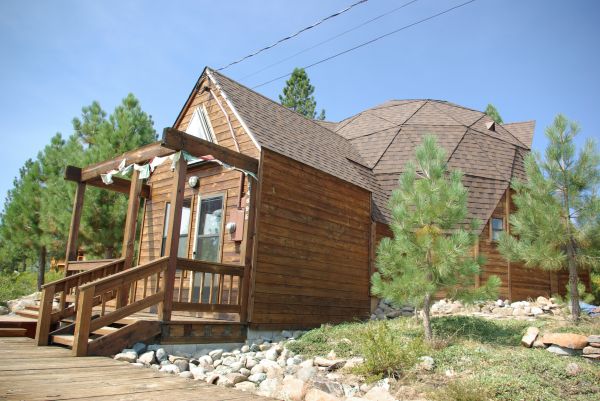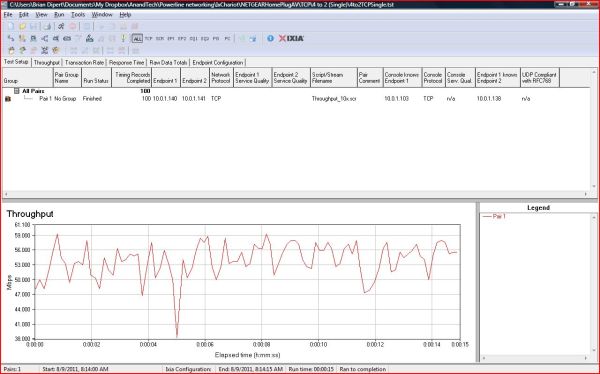Hands-On Powerline Networking: How Well (Or Not) Are Latest-Generation Devices Working?
by Brian Dipert on September 1, 2011 12:41 AM EST- Posted in
- Networking
- Powerline Adapters
- NetGear
My approximately 1300-square-foot geodesic-dome residence dating from the mid-1980s serves as my test bed.
Three of the powerline-network nodes I tested were in the approximately 25-foot-diameter downstairs main room:
- Against one wall in a dining-room nook (node 1)
- In the middle of the room on a stairwell near the entertainment system, (node 2)
- Against the opposing wall near the router (a 'fall 2007' Apple Airport Extreme N, model MB053LL/A, with GbE LAN ports).
Next door to the router is the "mud room", containing the fourth power outlet I employed in the testing (node 4), as well as the circuit-breaker box. I used another entertainment system in the upstairs bedroom as the fifth power-line node (node 3). Each AC outlet connects to a phase of the premises' 220V power feed, but I didn’t know (and intentionally didn't try to figure out, thereby mimicking a typical consumer's approach) which phase or which circuit breaker each network node employed.
Per the discussion in the prior section of this writeup, I employed various measures to minimize the effect of attenuation for these tests. I ensured that surge protectors and UPSs weren't between any of the power-line adapters and their associated power outlets. As a long-time powerline networking veteran, I have noise filters permanently installed between the power grid and both my refrigerator’s compressor and my home’s furnace fan; neither the refrigerator, furnace nor any other motors were operating when I was logging benchmark results. I also kept fluorescent bulbs extinguished, and I unplugged all of my AC adapters, battery chargers, and other wall-wart-based and otherwise AC-to-DC-fueled devices.
With respect to benchmarking utilities, AnandTech's Brian Klug leveraged iPerf (an open-source package I've also extensively used in the past) for his recent testing of Apple's latest generation Airport Extreme router and Time Machine. And Jarred Walton harnessed a suite of software in his more recent evaluation of Bigfoot’s Killer-N 1102 Wireless Half-Mini PCIe 1.1 add-in module. In my particular case, I went with another program I'd used before, Ixia's IxChariot. IxChariot’s Console utility, a Microsoft Windows application, sets up, manages, and periodically collects data from various tests.
The companion network-node-resident utility, Ixia’s Endpoint, runs on Linux, Mac OS X, and Windows OSes. Console comes with more than 100 company-created scripts, and users can also customize them and create brand-new scripts. Because Console also bundles Endpoint, you can theoretically run Console from the same machine that acts as one of the tested network nodes. However, as I'd learned in the past, such a setup is not optimal for accurate testing. Using the same system CPU resources for both Console and Endpoint means that you may be unable to run either of them at full speed. Console and Endpoint functions also contend for limited networking-transceiver bandwidth.
Alternatively, as I did in these particular tests, you can run Endpoint software on two systems, with the Console utility executing on a third computer that communicates with the other two. In that case, the Console-installed PC can also have lower network performance than the others. According to Michael Githens, lab-programming manager at Ixia, “It doesn’t need a high-speed connection, [as the test links do]. It is passing less data; the results come only from the test links, not the management links.” And in fact, the Console communication with each Endpoint in my particular setup occurs over Wi-Fi, so as to not impede the Endpoint-to-Endpoint traffic flow over the power grid (which would therefore under-report the performance potential of any particular powerline networking span).
However, I chose to disregard one other Ixia setup recommendation offered by Intellon-then-Atheros-now-Qualcomm, who sells the silicon inside two of the three powerline adapters tested in this study. Qualcomm suggested that I give the Endpoint systems' wired Ethernet transceivers (therefore the powerline adapters connected to them) static IP assignments, thereby enabling them to directly communicate with each other with no periodic router overhead. While Qualcomm's proposal is likely accurate in its prediction, it doesn't match the DHCP-assigned way that the bulk of LAN clients in both corporate and consumer settings obtain their IP addresses. As such, I left the Endpoints at their DHCP-configured defaults, thereby explaining the fifth powerline adapter in my topology, connected to the router for DHCP assignments (and renewals) and other like functions.
My Console-running system is a Dell XPS-M1330 laptop, based on Windows Vista Ultimate. As previously mentioned, it interacts with the two Endpoints over 802.11n Wi-Fi connections. The Endpoint systems are both Macs, a first-generation May 2006 13" MacBook running Mac OS 10.5 Leopard and an April 2010 13" MacBook Pro based on Mac OS 10.6 Snow Leopard. Both of the latter two systems contain GbE transceivers, a critical requirement for matching up with the GbE ports in the '500 Mpbs' IEEE 1901 powerline adapters I evaluated.












53 Comments
View All Comments
claytontullos - Thursday, September 1, 2011 - link
I have a netgear XAV1004 -200 system set up for my ps3.When the main unit is on the same breaker as the receiver I get around 35Mb/s. When I had the unit setup a few breakers away I received around 3.1Mb/s. Making the change as made all the difference in the world as I could not stream HD content before.
You really have to take these 200Mb claims as a joke... my gigabit switch tells me the main unit is connected to it at 100Mb/s... You'd expect if it was truly capable of 200Mbs/ speed it would connect at the gigabit level.
bersl2 - Thursday, September 1, 2011 - link
Maybe it only implements Fast Ethernet, and marketing is adding Tx and Rx bandwidth together.fireboy92k - Thursday, September 1, 2011 - link
It's 100 Mbps full duplex (just like fast ethernet), hence the claim of 200 Mbps as you stat.See answer 10 at http://support.netgear.com/app/answers/detail/a_id...
bdipert - Thursday, September 1, 2011 - link
Thanks for writing, claytontullos. The '200 Mbps' (or for that matter, '500 Mbps') claims of the powerline folks are analogous to the '54 Mbps' and above claims of the Wi-Fi folks...or for that matter the '100 Mbps' and '1 Gbps' claims of the wired Ethernet folks. The peak theoretical PHY rate (or even close to it) is rarely if ever achievable in real-life usage environments, due to protocol overhead, distance- and otherwise-derived attenuation, destructive interference from other 'transmitters' in the same frequency bands, etc...p.s...'200 Mbps' powerline networking adapters usually if not always contain 100 Mbps wired Ethernet transceivers. 'Nuff said ;-) Note, however, that the XAV5001 '500 Mbps' adapters contain GbE transceivers...therefore making it important that I mated them to Endpoint systems (my MacBook and MacBook Pro) which ALSO have GbE capabilities
JarredWalton - Thursday, September 1, 2011 - link
I wouldn't lump the 100Mbps and 1Gbps Ethernet stuff in with the WiFi and Powerline networking. I routinely hit >100MBps transfer rates on my GbE setup, and basically peg any 100Mbps connections at 98% of their maximum throughput (around 12.3MBps). And that's using HDDs. Transferring files from an SSD-based system to another SSD over GbE, I can hit around 120MBps. Fastest I've ever managed on WiFi is around 30MBps with a "450Mbps" connection -- or around 53% of the theoretical rate.Per Hansson - Thursday, September 1, 2011 - link
Yea, I agree, don't talk down Ethernet like thatI have a 100mbps internet connection and I can routinely hit 12MB/sec transfer speeds...
I've also used those "Gigabit" Powerline networking devices and they managed an astonishing 5mbps throughput, while at the same time killing my FM reception on my radio, even the cars radio was interferred with when I tried it out to my garage (throughput was then ca 1mbps, somewhat shy of the 1000mbps claim...)
bdipert - Thursday, September 1, 2011 - link
Ok, ok, ok...so maybe I was a little harsh on wired Ethernet...;-) In this regard, a compare-and-contrast is perhaps of some value. Wired Ethernet is a media specifically designed to carry network packets. The AC power grid, on the other hand, or the atmosphere, in both cases with who-knows-what attenuators and spectrum contenders in-between transmitter and receiver...And even with wired Ethernet, protocol overhead (TCP's handshaking scheme, for example...this is why I REALY wished I could have gotten some meaningful UDP data in this study) will retard the effective transfer rate, even if the media and the transceivers on either end are up to the task. And speaking of the receiver, a slow NAS (for example) does a good job of putting the brakes on things, too...
el1x - Thursday, September 1, 2011 - link
As far as i am aware its 100Mbps Full Duplex and the marketing states the Tx & Rx together as bersl2 has said.Any chance of looking at the NetComm range of powerline? The NP202, 203, 204 & 206.
I have a set of the NP204's not only are they a solid reliable unit they have AC passthrough so i don't lose a power point.
jigglywiggly - Thursday, September 1, 2011 - link
The problem with this is that it isn't that much better than wifi, lol.akedia - Thursday, September 1, 2011 - link
My apartment is long, narrow, and fully of radiators. It's also over a century old, and power outlets are distressingly sparse and often tucked half-behind the radiators. Right now I have to have coax strung across half my apartment to get from the bizarre place the cable for my internet connection enters the wall to the only outlet in a good enough position to have my WiFi adapter plugged in and get a signal that's still only serviceable throughout half of my apartment. In a perfect environment, yeah, powerline and WiFi are comparable in performance. In reality, though, there are real advantages and disadvantages to each that can dramatically affect their relative utility. Lots of radiators... only one breaker.